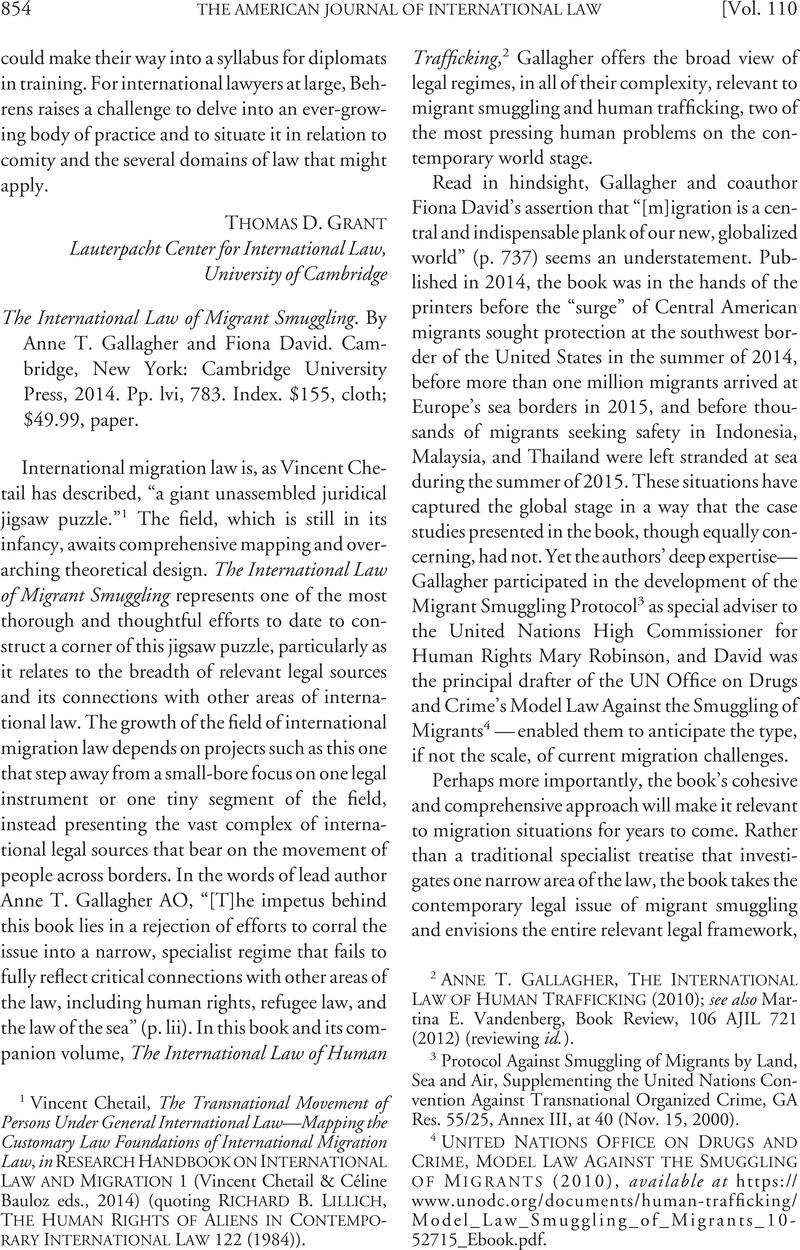No CrossRef data available.
Article contents
The International Law of Migrant Smuggling. By Anne T. Gallagher and Fiona David. Cambridge, New York: Cambridge University Press, 2014. Pp. lvi, 783. Index. $155, cloth; $49.99, paper.
Published online by Cambridge University Press: 29 March 2017
Abstract

- Type
- Recent Books on International Law
- Information
- Copyright
- Copyright © American Society of International Law 2016
References
1 Vincent Chetail, The Transnational Movement of Persons Under General International Law—Mapping the Customary Law Foundations of International Migration Law, in Research Hand Book on International Law and Migration 1 (Vincent Chetail & Céline Bauloz eds., 2014) (quoting Richard B. Lillich, The Human Rights of Aliens in Contemporary International Law 122 (1984)).
2 Anne T. Gallagher, The International Law of Human Trafficking (2010); see also Martina E. Vandenberg, Book Review, 106 AJIL 721 (2012) (reviewing id.).
3 Protocol Against Smuggling of Migrants by Land, Sea and Air, Supplementing the United Nations Convention Against Transnational Organized Crime, GA Res. 55/25, Annex III, at 40 (Nov. 15, 2000).
4 United Nations Office on Drugs and Crime, Model Law Against the Smuggling of Migrants (2010), available at https://www.unodc.org/documents/human-trafficking/Model_Law_Smuggling_of_Migrants_10-52715_Ebook.pdf.
5 Gallagher explicitly notes: “Unlike much scholarship in areas covered by the book, its authors do not take—or hide behind—a specific political stance” (p. liii).
6 For example, the authors explain that “current migration regimes reinforce discrimination and inequality and contribute to global suffering” and that “international law is ultimately a tool for change,” compatible with the “careful dismantling or reimagining of those regimes” (pp. 736–38).
7 See, e.g., Charlesworth, Hilary, Feminist Methods in International Law, 93 AJIL 379, 392 (1999)CrossRefGoogle Scholar (expressing skepticism of “the possibility of objectivity” in the international legal system, and concern that “neutral and impartial standards” are often disguises that perpetuate the privilege of dominant groups and the further marginalization of those excluded from the international legal regime).
8 UN Convention Against Corruption, GA Res. 58/4 (Oct. 31, 2003).
9 It should be noted that these obligations, though often conflated, are grounded in different treaties and differ in scope and applicability.
10 International Covenant on Civil and Political Rights, Dec. 16, 1966, 999 UNTS 171.
11 In one example, the authors provide a thorough description of the European Court of Human Rights’ jurisprudence on collective expulsion (pp. 477–78), which has already developed since the book was published. See, e.g., Jaya Ramji-Nogales, Prohibiting Collective Expulsion of Aliens at the European Court of Human Rights, ASIL Insights (Jan. 4, 2016), at https://www.asil.org/insights/volume/20/issue/1/prohibiting-collective-expulsion-aliens-european-court-human-rights.
12 Protocol to Prevent, Suppress and Punish Trafficking in Persons, Especially Women and Children, Nov. 2, 2000, UN Doc. A/55/383, at 53, 40 ILM 377 (2001).
13 The term creep is a reference to Chuang, Janie A., Exploitation Creep and the Unmaking of Human Trafficking Law, 108 AJIL 609 (2014)Google Scholar.
14 See, e.g., Sara Kendall & Sarah Nouwen, Representational Practices at the International Criminal Court: The Gap Between Juridified and Abstract Victimhood, 76 L. & Contemp. Probs., nos. 3–4, 2013, at 235, available at http://scholarship.law.duke.edu/lcp/vol76/iss3/7.


